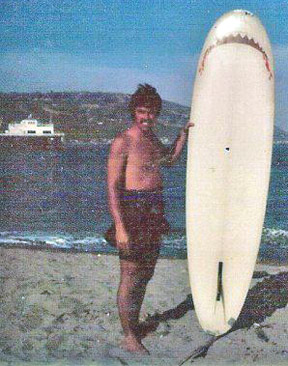Some Thoughts On "HULLS"

Some Thoughts On "HULLS"

Several years ago an article in Surfer's Journal regenerated interest in the style of surfboard described as "hulls" that I have made since their first popularity in the late 1960's through the 1980's. Many surfers have again found these designs to be an enjoyable way to ride waves. Here are my original thoughts after this new exposure:
"Lately there have been many inquiries
into the "hull" style of surfboards that I build. The name "hull" is in my opinion a misnomer. Surfboards are planing hulls. It is true that the original designs from which the contempory boards evoled were more "hull" like having a more forward convex bottom that did push water out of the way until with enough power the board would come up to plane. Explained next.
The first boards we made
using the extreme Greenough concept as our model were difficult to ride
and needed the right kind of power to make them "go" aka "plane".
We did not always have the ideal waves, particularly
during the Southern California summers.
To accommodate the conditions,
the boards increased in length and width (planing area), the rocker was modified,
and the "hull" was softened, particularly in the front
entry portion of the board. This enabled us to trim more forward
and plane out in waves with very little power, particularly the
small "cobblestone" point surf available.
There were certainly days
when the full on forward hull designs would work to their potential
and some of those days have been documented, but the huge percentage
of waves available were not ideal for the very forward convex hull designs.
I in particular only surfed
Malibu, Little Dume ( with rare success), California Street, Pitas
Point, Rincon and Cojo on the Hollister Ranch. These are
rare group of not perfect but very good lined up right point break or point breaks like waves. Waves that have a continuity in shape, tension, where the power exists and the average size.
The boards that I like
to call "modified transitional volume planing hulls" evolved
to ride these waves. I understand that there are surf spots throughout
the planet that have elements of these waves and these designs
will certainly work at some level at many of these breaks.
It is these wave where
the "point break" outline on the website evolved. This
was the shape I rode with subtle variations and incremental changes in length. The last ones which seemed the most efficient and applicable in most condition were in the 7' to 7'1" range. I had many other customers who developed their own unique
style and we modified the templates to fit. There were literally
a hundred different templates and the designs varied in many aspects: shorter, longer, wider, narrower,
thinner, thicker etc.
My boards were sometime
stringerless to give the ride more feeling in very small waist
to head high surf; the typical size of a "swell" in
the Southern California area. Not till I visited Hawaii in 1989
did I have to adapt the design to the local condtions. With these modifications I now had
a board that worked fine in larger California surf. The Hawaii plan
shape was a result of that visit.
Many templates were developed with design changes in rocker and bottom contour to accomodate customers who surfed
beach breaks, short pocket reef breaks, surfed backside etc. The outlines on my website show
only a few of these designs that became somewhat popular during
the era and covered more types of surf than the "point breaker"
I am now seeing feedback,
particularly on the Swaylocks forum website (http://swaylocks.com)
of disgruntled surfers who have tried some versions of these designs
and do not like the ride.
This was very true during
their development in the early 1970"s. Individuals often
tried the wrong outline at the wrong spot with the wrong expectations
and gave up on the design, going back to the flat bottom, low
railed, tail fin anchored "thrusters" etc that could
be pivoted off the tail and maneuvered at will.
To each his own of course
but my complaint is that they do not understand that these boards
are not for the onlooker. It is not meant to be a visual experience.
It is for the "feel" of these board. Not that visual
observation of the ride cannot be enjoyed. To me it is quite beautiful
the way they "fit" to the wave and become part of it.
This of course is not
mainstream and it never has been. During the 1970' through the
1980"s only about 10% of the boards I made were these designs.
I made everything within reason and some not so reasonable. Some
have turned up and are in the photo section of this website.
Surfing has become very
diverse over the last several years with interest in longboards
of all sizes, the fish design etc.
Just as many have found the "longboard" experience of
glide and trim being very rewarding so others have found that
going through and over the water and attaching themselves to the wave in
a unique way on one of these craft is indeed rewarding.
There are many approaches
to riding a wave. Many are now engaged in the stand up, paddle
in approach and as with all approaches it can be dreadful
in the wrong hands with the wrong attitude.
With this in mind, before
you pursue this design, give some thought to what you want from
the experience and the waves that you will be riding. Talk to
others that have some experience with these boards and don't jump
into one because there was an article in a surfing publication.
Mahalo for your time!
Aloha! Greg